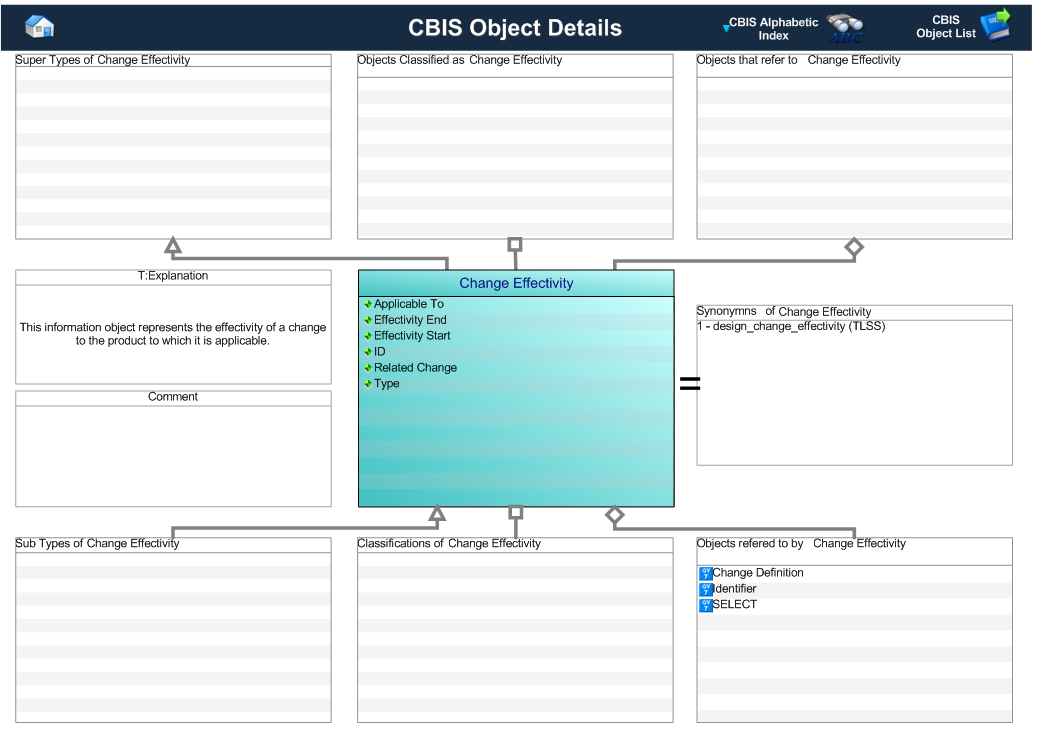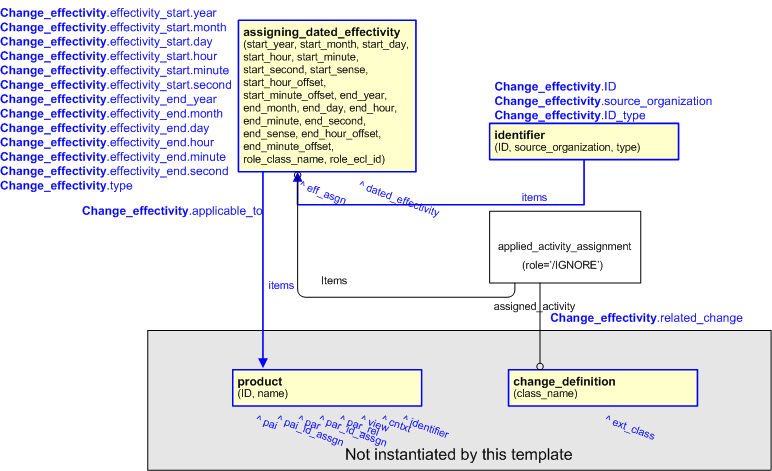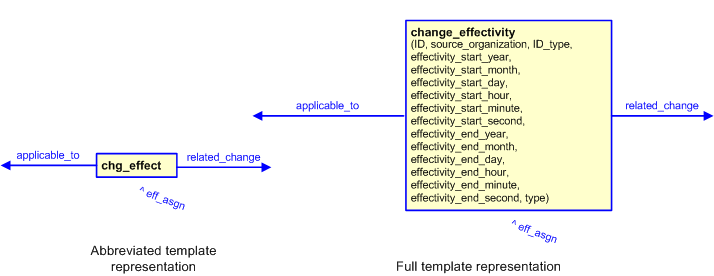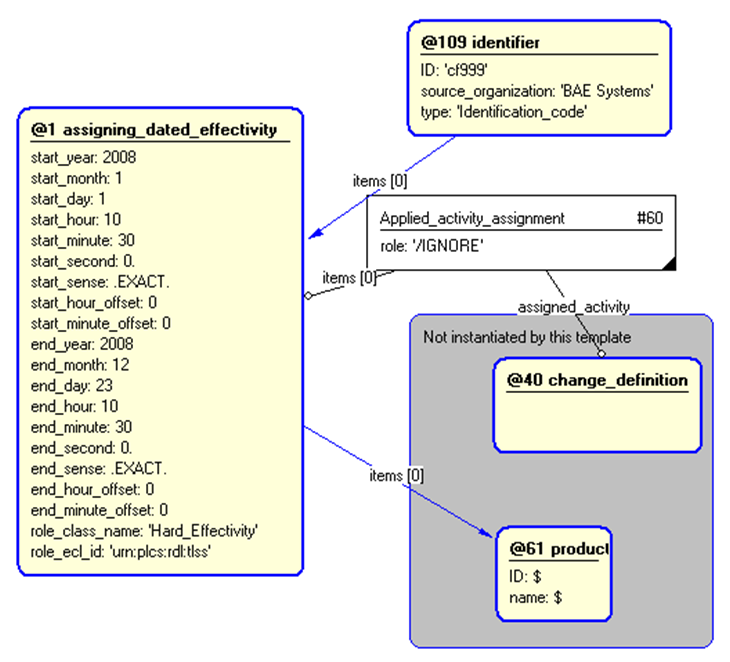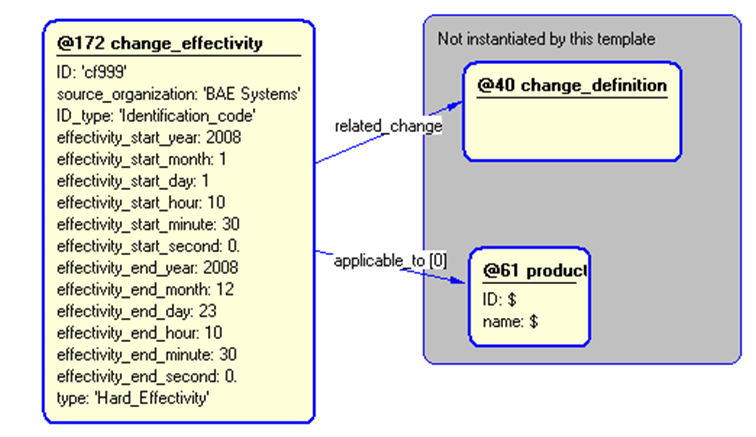Template:— change_effectivity (chg_effect)
Context:— UK_Defence |
Date: 2009/04/17 10:29:28
Revision: 1.2
|
This section specifies the template change_effectivity.
NOTE
The template has been defined in the context of
UK_Defence.
Refer to the business context for details of related templates.
NOTE
An explanation of a template and the associated instantiation path is
provided in the
Template overview
section.
This template describes how to represent a UK_Defence change effectivity, using
.
This information object represents the effectivity of a change to the product to which it is applicable.
For further information about the representation of a change effectivity, see below.
This information object represents the effectivity of a change to the product to which it is applicable.
Figure 1 — Graphical Representation for Business Object Change Effectivity
Record:
This information object represents the effectivity of a change to the product to which it is applicable.
|
Attribute name
|
Attribute description
|
Attribute type
|
Optionality
|
| Applicable To |
This is the reference to the item to which the Change Effectivity applies |
SELECT |
Mandatory |
| Effectivity End |
This is the date and time on which the effectivity of the Change to the applicable
item ceases to be valid.
|
Intrinsic |
Optional |
| Effectivity Start |
This is the date and time on which the effectivity of the Change to the applicable
item becomes valid. Also the requirement for effectivity start date is optional it is currently mandatory
in PLCS. Issue raised against PLCS. This template will make effectivity start date mandatory until PLCS
has been amended.
|
Intrinsic |
Optional |
| ID |
This is the Identifier of the Effectivity. |
Identifier |
Mandatory |
| Related Change |
This is the reference to the Change for which the Change is Effective. |
Change Definition |
Mandatory |
| Type |
This is the type of the Effectivity.
The categories may include:
"Hard Effectivity - Required incorporation";
"Soft Effectivity - Expected but not mandatory incorporation.
|
Intrinsic |
Optional |
Table 1 — Change Effectivity attribute details
The EXPRESS-G diagram in
Figure
2
shows the templates and EXPRESS entities that are required
to represent the template
"change_effectivity".
The text highlighted in blue shows the template parameters.
Figure 2 — An EXPRESS-G representation of the Information model for change_effectivity
The graphic for the template to be used in other EXPRESS-G diagrams
is shown in Figure
3
below.
Figure 3 — The graphical representation of the change_effectivity template
The following input parameters are defined for this template:
The identifier of the product.
The organization that created the associated identifier. Additionally
a Person or Information System could be defined when either of
these are the source; see identifier characterizations
This is the name of the type of the class used to classify the identifier and so
provide the role or reason for the identification.
The following classes and their sub-classes can be used:
Year_component of the date and time on which the effectivity of the Change to the applicable item
becomes valid.
This parameter is optional. If not given, it will remain unset.
Month_component of the date and time on which the effectivity of the Change to the applicable item
becomes valid.
This parameter is optional. If not given, it will remain unset.
Day_component of the date and time on which the effectivity of the Change to the applicable item
becomes valid.
This parameter is optional. If not given, it will remain unset.
Hour_component of the date and time on which the effectivity of the Change to the applicable item becomes valid.
Minute_component of the date and time on which the effectivity of the Change to the applicable item becomes valid.
This parameter is optional. If not given, it will remain unset.
Second_component of the date and time on which the effectivity of the Change to the applicable item becomes valid.
This parameter is optional. If not given, it will remain unset.
Year_component of the date and time on which the effectivity of the Change to the applicable item
ceases to be valid.
This parameter is optional. If not given, it will remain unset.
Month_component of the date and time on which the effectivity of the Change to the applicable item
ceases to be valid.
This parameter is optional. If not given, it will remain unset.
Day_component of the date and time on which the effectivity of the Change to the applicable item
ceases to be valid.
This parameter is optional. If not given, it will remain unset.
Hour_component of the date and time on which the effectivity of the Change to the applicable item
ceases to be valid.
Minute_component of the date and time on which the effectivity of the Change to the applicable item
ceases to be valid.
This parameter is optional. If not given, it will remain unset.
Second_component of the date and time on which the effectivity of the Change to the applicable item
ceases to be valid.
This parameter is optional. If not given, it will remain unset.
This is the reference to the item to which the Change Effectivity applies.
The reference to the subject of the change after the change is applied.
type (Default=Effectivity_assignment,Type='CLASS')
This is the type of the Effectivity. As type of effectivity is mandatory in PLCS the
default of "Effectivity_assignment" is used and overwritten as required.
The following classes and their sub-classes can be used:
classifications: [Hard_effectivity]![[warning:]](../../../../../../images/dex/warning.gif) Error RDL4: The URI urn:plcs:rdl:uk_defence is not listed in dexlib/data/refdata/rdl_index.xml[Soft_effectivity]
Error RDL4: The URI urn:plcs:rdl:uk_defence is not listed in dexlib/data/refdata/rdl_index.xml[Soft_effectivity]![[warning:]](../../../../../../images/dex/warning.gif) Error RDL4: The URI urn:plcs:rdl:uk_defence is not listed in dexlib/data/refdata/rdl_index.xml
Error RDL4: The URI urn:plcs:rdl:uk_defence is not listed in dexlib/data/refdata/rdl_index.xml
"Effectivity_assignment"
(urn:plcs:rdl:std:Effectivity_assignment)
The following reference parameters are defined for this template:
Allow the
Effectivity_assignment
entity instantiated in this path to be referenced when this template is used.
%^target = $change_effectivity.eff_asgn%
The following parameter combinations specify a uniqueness constraint:
Unique constraint: Unique change effectivity
Each instance of the
entity
(
Effectivity_assignment)
within the data set shall be uniquely identified
by a combination of the following parameters on this
template (change_effectivity) namely:
ID,
applicable_to,
related_change.
The
instance is
referenced by the following template parameter:
eff_asgn.
The instantiation path shown below specifies the entities that are to be
instantiated by the template.
A description of templates and the syntax for the instantiation path is
provided in the
Templates Help/Information section.
/
assigning_dated_effectivity(
start_year=@effectivity_start_year,
start_month=@effectivity_start_month,
start_day=@effectivity_start_day,
start_hour=@effectivity_start_hour,
start_minute=@effectivity_start_minute,
start_second=@effectivity_start_second,
start_sense='.EXACT.',
start_hour_offset='0',
start_minute_offset='0',
end_year=@effectivity_end_year,
end_month=@effectivity_end_month,
end_day=@effectivity_end_day,
end_hour=@effectivity_end_hour,
end_minute=@effectivity_end_minute,
end_second=@effectivity_end_second,
end_sense='.EXACT.',
end_hour_offset='0',
end_minute_offset='0',
role_class_name=@type,
role_ecl_id='urn:plcs:rdl:uk_defence',
items=@applicable_to)/
%^eff_asgn = $assigning_dated_effectivity.eff_asgn%
/
identifier(
ID=@ID,
source_organization=@source_organization,
type=@ID_type,
items=^eff_asgn)/
Applied_activity_assignment-- Set the Applied_activity_assignment Applied_activity_assignment.role = '/IGNORE'
Applied_activity_assignment.items ->
^eff_asgn
Applied_activity_assignment.assigned_activity ->
@related_change
The following entities are instantiated with attributes as specified:
The instance diagram in Figure
4
shows an example of the EXPRESS entities and templates that are instantiated by the template:
/change_effectivity(effectivity_start_year='2008', effectivity_start_month='1', effectivity_start_day='1', effectivity_start_hour='10', effectivity_start_minute='30', effectivity_start_second='0', effectivity_start_year='2008', effectivity_start_month='12', effectivity_start_day='23', effectivity_start_hour='10', effectivity_start_minute='30', effectivity_start_second='0', type='Hard_Effectivity', applicable_to='@61', ID='cf999', source_organization='BAE Systems', ID_type='Identification_code', related_change='@40')/
(an illustration of the consolidated change_effectivity template is shown in
Figure
5 below.)
Figure 4 — Entities instantiated by change_effectivity template
The instance diagram in
Figure
5
shows the graphic symbol for the template that is to be
used in other instance diagrams. The example template is:
/change_effectivity(effectivity_start_year='2008', effectivity_start_month='1', effectivity_start_day='1', effectivity_start_hour='10', effectivity_start_minute='30', effectivity_start_second='0', effectivity_start_year='2008', effectivity_start_month='12', effectivity_start_day='23', effectivity_start_hour='10', effectivity_start_minute='30', effectivity_start_second='0', type='Hard_Effectivity', applicable_to='@61', ID='cf999', source_organization='BAE Systems', ID_type='Identification_code', related_change='@40')/
Figure 5 — Instantiation of change_effectivity template
Characterizations
No common characterizations of the template
change_effectivity
have been identified. However, the ISO 10303-239 EXPRESS model
may enable other assignments to the entities instantiated by the template.
